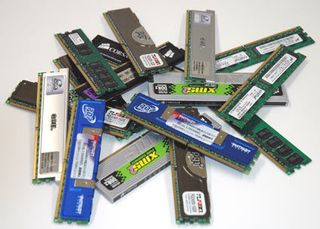Separating The Wheat from the Chaff: The Latest DDR2 Modules Tested
The Latest DDR2 Modules For 266 And 333 MHz Tested

In what had to be their most extensive platform switch ever, about six months ago Intel launched the Pentium 4 platform based on the 900 chipset series and LGA Socket 775. One of the main components introduced was DDR2 memory, which achieves much higher transfer speeds than DDR400 due to its lower supply voltage and double prefetch feature.
Until now, however, the theoretical performance boost has not manifested itself in conjunction with the 915P and 925X/XE chipsets. Despite the clock speed increase from 200 to 266 MHz on the interface, DDR2 memory in dual-channel operation remains faster only in theory. The reason for this is the timings, which are significantly worse than those for standard DDR RAM modules. Only once the speed becomes a good sight faster than DDR400, as will occur for DDR2-667 and DDR2-800, will the higher bandwidths compensate in real life for the disadvantages posed by the looser timing parameters.
The first Socket 775 systems had some teething troubles to contend with, as our initial motherboard comparison test proved. In addition, the high-end Pentium 4 models were a rare find in stores for the first three months after the launch. Of those who did have the good fortune of being able to buy one, many were not thrilled with the high heat loss.
It was not until the end of 2004 that Intel began to introduce to the market redesigned processors with the "E" stepping. These models are compatible with Enhanced SpeedStep, which slows down the CPU to as little as 2.8 GHz under light load, thus significantly reducing thermal loss in all operating modes except sustained full load.
Due to these obstacles, sales of Socket 775 systems in 2004 were far worse than the industry had hoped. High production runs were the only thing that could increase profits and ultimately cause memory prices to fall.
In the meantime, however, the boards have clearly come of age, and Intel's already- attractive processor offering is set to receive another boon with the Pentium 4 600. Look for 2 MB L2 cache and, of course, Enhanced SpeedStep. As a result, sales of DDR2 systems should also start rising soon, which means it now makes sense to conduct a first comparison test of conventional DIMMs.
This time we did not ask every manufacturer to send us their latest memory modules; instead, we just "test drove" the modules that have reached our lab over the last few weeks and months. Let's see what we found.
Stay on the Cutting Edge
Join the experts who read Tom's Hardware for the inside track on enthusiast PC tech news — and have for over 25 years. We'll send breaking news and in-depth reviews of CPUs, GPUs, AI, maker hardware and more straight to your inbox.
Current page: The Latest DDR2 Modules For 266 And 333 MHz Tested
Next Page DDR2-667 Doesn't HurtMost Popular

